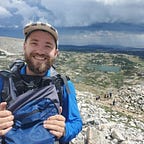Practice storm safety in your woods before trying your luck in the Tetons. It’ll save your socks, your mood, and maybe your life.
Every sport has its practice field — an environment where you can make mistakes in low-consequence situations that you learn from later on. Your backpacking home base is a familiar environment where you feel comfortable enough (stakes are low) to experiment, learn, and practice skills before needing them in the future.
You never want to be learning in the same situation you need to execute. It’s stressful. And it usually ends poorly.
Sometimes failures are really funny. Sometimes they’re deadly. But mostly, a trip in the woods gone wrong leads to a classic suffer-fest. But practicing at home base can allow you to hone select skills and experiment with new ones, reducing the amount of needless suffering you’ll need to endure on a bigger trip.
I chose two overarching, broad skills that I’ve needed, and failed to use, on camping trips. Several other important skills follow below their umbrellas. I now practice them in my home-base at Mohican State Forest, in Ohio.
Controlling your Temperature
However the weather is, you are always trying to change it. When it’s hot, you want to be cool. When it’s cool, you want to be warm. When it rains, you want to be dry.
Practice pitching your tent in the rain. Hike twelve miles in August heat. Camp when it snows. Exposing yourself to different weather builds your resiliency in the clothes you wear, the gear you bring, and the way that you pack. I have also found that it’s better to be soaking wet in November somewhere you’re familiar with than in remote, novel wilderness.
Controlling your orientation
I thought I knew how to read a map until it was my turn to lead a trip without cell signal or any experience in the area. We got turned around and walked in a three-mile circle. Seven miles turned into thirteen. I am still known as the shitty navigator.
Learn how to read elevation lines. Judge distances. Follow trail maps. Identify water sources.
Orienting properly also includes reading weather patterns. If a sheet of gray stratus is sliding over you, do you want to camp in the valley beside the river? If a cumulus clouds are cooking up a storm, do you want to camp in an upland forest or near a ridge?
It’s also useful to get lost. Not lost lost, as in needing to be rescued, but like, somewhat lost, when you’re just unsure of your direction. This can be accomplished by hiking at night. This one is a little trickier, and more dangerous.
Also, practice hiking at night in case we ever go on a trip together and I navigate us three miles the wrong way, and we have to hike to camp in the dark.
It is impossible to fully control any aspect of the outdoors. That’s why we love it, I suppose. Nature shows us how little control we really have over the world. But we can control our temperature, and our sense of direction (to an extent). It just takes practice.
Practice regulating your temperature and properly orienting yourself in a setting that you’re comfortable in. A home base. Backpacking needs practice too. Sure, you could wing it on that sexy trip to Colorado. It’ll make for a good story — or you’ll be forced to go home early (or worse).
As my alpha male, bicep-ripping football coach used to tell us, you either “fail to prepare, or prepare to fail.” In backpacking, it’s helpful to practice failing. It’ll help you fail a little less later on.
